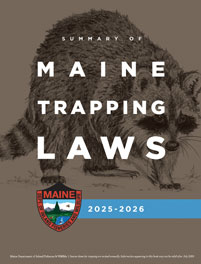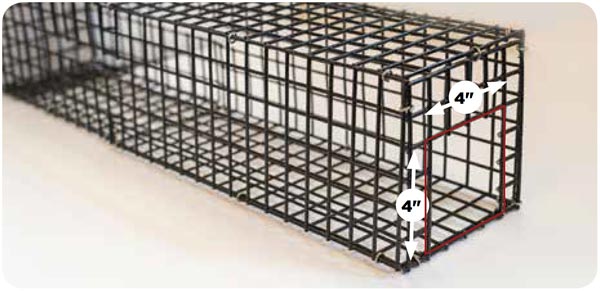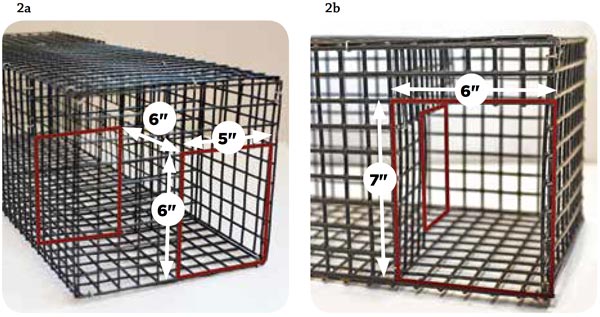Home → Hunting & Trapping → Trapping → Laws & Rules → Killer-Type (Conibear) Trap Rules
Killer-Type (Conibear) Trap Rules

It is unlawful to use a killer-type trap with a jaw spread larger than 8 inches, except during the open season on beaver. These traps may only be used if when set, placed, and tended, the trap is completely underwater.
Killer-type traps with a jaw spread of 8 inches or less do not need an exclusion device if when set, placed, and tended, are completely underwater.
Killer-type traps with an inside jaw spread of 5 inches or less do not need an exclusion device if: 1) when set, placed, and tended, they are completely underwater, or if 2) the trap has an inside jaw spread 5 inches or less AND is:
- Either set so as to be partially covered by water at all times, or
- Set under overhanging stream banks, or
- Used as a blind set (without the use of bait, lure or visible attractor). Bait, lure and visible attractor do not include animal droppings (scat) or urine.
Lynx Exclusion Device Rules
In all WMDs, killer-type traps with a jaw spread not to exceed 8 inches may be used on or above ground level if the trap is placed within a lynx exclusion device. The trap jaws must be completely within the device, the trap springs can be outside of the device.
Exclusion devices will have the following designs:
- For traps with a jaw spread less than or equal to 5 inches (primarily used for marten trapping), the device must have an opening of 4 x 4 inches or less. The entrance hole may be placed on the end or on the side of the device, and the trap must be set a minimum of 18 inches from the closest edge of the entrance hole. (See Figure 1 below).
- For traps with a jaw spread greater than 5 inches but less than 8 inches, (primarily used for fisher trapping) two designs may be constructed. For both devices the trap must be placed no closer than 18 inches from the closest edge of the entrance hole.
- The first design has an entrance hole on the end of the device that must not exceed 5 x 6 inches. A baffle must be placed no more than 6 inches back from the entrance hole and must not leave an opening greater than 5 x 6 inches. With the baffle in place, the entrance hole and interior opening must not overlap to cre-ate an unobstructed view to the interior of the exclusion device (See Figure 2a below).
- For the second design the entrance hole must not exceed 6 x 7 inches and must beplaced on the side of the device. A baffle must be placed at the edge of the entrancewith the baffle opening opposite of the entrance hole, and the interior opening must not exceed 6 x 6 inches (See Figure 2b below).
Requirements for Exclusion Devices
- Exclusion devices can be constructed of wood, plastic, or wire mesh. If using wire mesh, the mesh cannot exceed 1½ by 1½ inches, or 1 inch by 2 inch openings (side to side). The wire mesh has to be 16 gauge or less (wire diameter of 0.05 inches or greater).
- The opening slot in the exclusion device that allows the trap springs to extend outside the device can be no more than 7½ inches wide and a height of no more than 1½ inches.
- The back of the device must be secured to withstand heavy pulling; if using wire mesh with a wood or plastic box, the wire mesh must wrap around two opposite sides of the box and be securely fastened.
- When there is a joint, there must be a secure attachment point on two opposite sides of the device to ensure the device does not separate when set.
- The trap must be securely anchored independent of the exclusion device.
- Bait must not be visible from above and it must be covered in such a way as to withstand wind action and other normal environmental conditions.
- When enclosed in an exclusion device, killer-type traps can be set directly on the ground, or elevated in trees or on poles, with no specific requirements as to the height above ground or diameter of the tree or pole.

Figure 1. All exclusion devices have a 4 x 4 inch opening and are constructed for a killer-type trap with a jaw spread less than or equal to 5 inches (primarily used for marten trapping).

Red lines illustrate the locations of the entrances.
Figure 2. Legal exclusion devices for killer-type traps having a jaw spread between 5 and 8 inches.
2a. Is an example of a device with an entrance hole on the end of the device. The entrance hole must not exceed 5 x 6 inches. A baffle must be placed no more than 6 inches back from the entrance hole and must not leave an opening greater than 5 x 6 inches. With the baffle in place, the entrance hole and interior opening may not overlap to create an unobstructed view to the interior of the exclusion device.
2b. Is an example of a device where the entrance hole is placed on the side of the device and must not exceed 6 x 7 inches. A baffle must be placed at the edge of the entrance with the interior opening opposite of the entrance hole, and the interior opening must not exceed 6 x 6 inches.